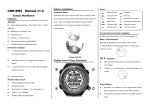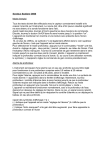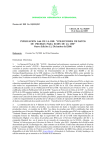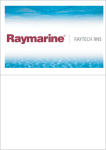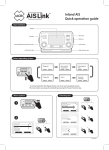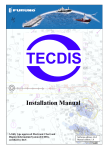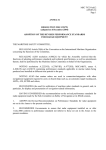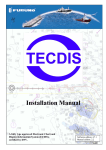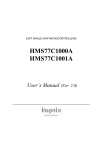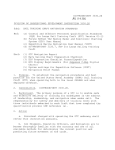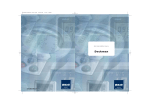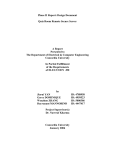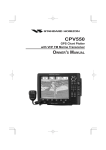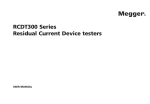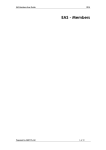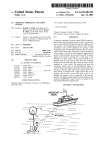Download Electronic charting
Transcript
PC Maritime http://www.pcmaritime.co.uk Electronic Charting – A practical update for superyachts David Edmonds 1. Introduction Electronic Chart Systems have been available for a decade and their main benefits are well recognised. Until a few years ago the cartography came from private companies. Today there are new choices with Hydrographic Offices providing official electronic chart services. The UK HO’s world-wide catalogue of over 2800 ARCS raster charts has been a major factor in building confidence in the market with 110,000 ARCS charts and 1200 systems sold in little more than 12 months. The NOAA/BSB raster chart catalogue of 1016 official raster charts has been very successful in the US with chart and PC-based systems sales of 750,000 and 10,000 respectively (July 1997). These charts have gained the ascendancy in their respective markets because of their quality, up-to-dateness and official government backing. Both “official” formats are supported by chart update services. The BSB format also provides pilotage and photographic information addons. Similar developments are underway in Europe. A lively raster v vector debate has arisen and in this paper I will attempt to explain the difference between the chart types and their relative strengths and weaknesses. With the advent of official raster charts a new Raster Chart Display System (RCDS) performance standard has been submitted to IMO. I will put this into context against ECDIS and ECS. In the course of considering RCDS the IMO have requested trials and user feedback and I outline some of the results of these. I would like to draw your attention to the need for training and a good support relationship with your supplier. To show how electronic chart regimes are forcing greater awareness of some long standing technical issues, I explain why you need to attend to horizontal datum shifts between GPS and charts. Finally I provide a list of questions which I believe you should be asking of any system before purchase and our website gives more detail at http://www.pcmaritime.co.uk 2. System Types 2.1 Electronic Chart Display and Information Systems (ECDIS) Only one performance standard has been approved at IMO, and that was for ECDIS in November 1995. This standard applies to vessels governed by the SOLAS convention who would comply with the carriage requirement for charts with an ECDIS system using Electronic Nautical Charts (ENCs). The chart data used in an ECDIS must conform to the Electronic Nautical Chart (ENC) S-57 specification. There are few ENCs available today and without an ENC an ECDIS is not an ECDIS. An ENC must be issued for use on the authority of government authorised hydrographic offices. Paper given at Project 97, METS, Amsterdam Page 1 of 13 A Practical Update to Electronic Charting PC Maritime http://www.pcmaritime.co.uk Some trial data is in use but widespread coverage will not be available for some time and some regions of the world may never become available in ENC form. For example the UK HO, who are leading the production of ENCs, have the following schedule: • Product Trials ................................................................................early 1998 • Pilot service stage ...................................................................................1999 • Commercial service with significant data .........................................2000 on Coverage will be patchy with major ports such as Harwich, Thames and Southampton given priority. Smaller ports and remote coastlines will be treated on their merits and may never be converted to ENCs. Although I have no figures it is certain that ENCs will be more expensive than Raster Nautical Charts (RNCs) or privately produced vector data. 2.2 Raster Chart Display Systems (RCDS) Recognising the delays in implementing ECDIS, various hydrographic offices identified a need for alternative official chart data to connect the small pockets of ENCs expected over the next few years. This led to the development of the Admiralty ARCS raster chart and NOAA’s BSB raster chart. Both formats come from the same production process used for paper charts and are in every respect identical to the paper versions. Of course, the electronic version has many more capabilities than paper, one of the most important being the ability to automatically merge chart updates (notices to mariners). A RCDS performance standard has been submitted to IMO. This performance standard is modelled very closely on the ECDIS performance standard and incorporates important requirements including: • Continuous chart plotting • Chart updating. • At least the same quality of display as the hydrographic office paper chart • Extensive checking, alarms and indicators concerning the integrity and status of the system. • Route planning and voyage monitoring. For Mega yachts and other non-SOLAS vessels RCDS is a useful standard against which to measure the systems on offer. 2.3 Dual Fuel Systems A Dual Fuel System is one that is either an ECDIS or RCDS depending on the type of chart data in use. ENCs are scarce so there are few opportunities to use ECDIS whereas RNCs are available now in large numbers and can perform two important functions: • Provide official electronic chart coverage for areas not covered by ENCs • Provide link coverage between the ENCs that are available. For the future, a system should provide a choice of cartography, whilst ensuring that navigation calculations are consistent, regardless of the background chart. For example, in my company’s system, Navmaster, world-wide variation is not derived from charts, and tidal stream is calculated from validated tidal data models, rather than from chart-specific data. Thus when a route is calculated, the result will be constant, whether the plan is drawn on a raster or a vector chart. Paper given at Project 97, METS, Amsterdam. Page 2 of 13 A Practical Update to Electronic Charting PC Maritime http://www.pcmaritime.co.uk 2.4 Electronic Chart Systems (ECS) An ECS is a system that does not conform to either the ECDIS or RCDS performance standards. There are no official performance standards applicable to this type of system. The IMO are working on an advisory document “Guidelines for the use of ECS”. The rule of thumb to apply is that a system is an ECS if: • It is using chart data (of any type) which is not issued under the authority of a government authorised hydrographic office. • Vector chart data is not in S-57 format. • The system does not meet the standards of either ECDIS or RCDS performance standards. So the first question to ask of any system is QUESTION 1 To what extent does the system conform to either the ECDIS (if vector) or RCDS (if raster) performance standard? And the second question is: QUESTION 2 Does the system offer choice of cartography preferably with both vector and raster types? 3. Chart types 3.1 Privately produced vector Privately produced vector charts are generally manufactured from scanned hydrographic office paper charts. The scanned image is then digitised by tracing the lines and features on the chart. This vectorisation process stores chart features in “layers” which can be redrawn automatically at an appropriate size as you zoom into the chart. You can add or remove categories of data such as spot depths, depth contours, navigation marks etc. In some systems you can query specific chart items, eg to get more information on a navigation light. The grouping of the data mirrors the paper chart regime. However the nature of the vector display is such that the chart data is not displayed electronically as it was compiled (as a paper document) and the original cartographic design of the paper chart is lost. Most systems automatically decide on the information to be displayed, depending on the level of zoom, to avoid the image becoming cluttered. Hence a new operational regime has to be developed to take into account the implications of: 1. Adding or removing layers of data 2. Zooming and seeing more or less data appear according to the level of zoom 3. Displaying the chart at a larger scale than the source paper chart 3.2 Official Raster There are two official raster chart formats • ARCS (UK HO) and Seafarer (Australian HO) both produced in the UK HO’s proprietary HCRF format. ARCS is updated weekly with the same information as the weekly Notice to Mariners used to correct BA paper charts. Seafarer is updated monthly on a similar basis. Paper given at Project 97, METS, Amsterdam. Page 3 of 13 A Practical Update to Electronic Charting PC Maritime http://www.pcmaritime.co.uk • BSB raster charts contain all the detail found in NOAA paper charts, with updates published every 30 days. Weekly Notice to Mariner updates will be available in the second quarter of 1998. These will be distributed via the Internet and will be completely in-sync with the US Coast Guard, NIMA and Canadian notices. Raster charts are direct facsimiles of paper charts and directly mirror the paper chart regime. The cartographic design (ie the chart data which should be displayed at a given scale) is maintained. Raster charts are often referred to as being “simple images”. Far from being “simple”, official raster charts incorporate considerable “meta data” which allows all chart information: notes, source diagrams, tidal diamonds, horizontal and vertical datums etc, to be displayed clearly and quickly. They are very accurate representations of the original paper chart with every pixel referenced to a latitude and longitude. Horizontal datum shifts are included with each chart to enable the chart and any information overlaid on it, to be referenced back to WGS-84. Chart file sizes are larger than their vector counterparts but redraw times are not significantly slower than commercial vector charts. A common misconception is that all raster charts are produced by the same “simple” technology. The following table, compiled from information supplied by BSB Electronic Charts and the UK HO, indicates variations between raster chart types. Feature ARCS BSB Maptech Government authorised Yes Yes No Entire catalogue always up-to-date to latest notice to mariner Yes Yes (from Qtr 2 1998) No Update service Weekly Weekly (from Qtr 2 1998) not known Original scan from: stable colour separates used for printing paper charts stable mylar film originals used for printing paper charts paper copy Scan resolution 1016 dpi 762 dpi 250 dpi Chart resolution 127 dpi1 256 dpi 160 dpi 2 3 Anti-aliasing Yes No No of points used to relate the chart image to Lat/Long co-ordinates. Pixel to position conversion is by calculation and is accurate to 1 pixel. 10-20, pixel to location conversions are also provided, accuracy depends No 4 1 The UK HO point out that the decision to adopt 127 dpi resolution for ARCS was founded on screen technology. When displaying all pixels on a typical screen there is a modest enlargement of the image compared to a paper chart. Higher resolution either requires greater enlargement or the use of sub-sampling neither of which improves image quality. 2 The automatic removal of the rough or jagged edges which can appear in images. 3 BSB Electronic charts comment that anti-aliasing is not needed on a 256 dpi chart. Paper given at Project 97, METS, Amsterdam. Page 4 of 13 A Practical Update to Electronic Charting PC Maritime http://www.pcmaritime.co.uk Feature ARCS BSB on the printed chart Maptech Geodetic datum shifts Yes Yes No Integrity checks 32 bit CRC check on original and updated image Byte checksums are included in chart file Not known Liability UK government accept liability on Hydrographic Office products US Government accepts liability for errors on NOAA charts Not accepted 3.3 Electronic Nautical Chart (ENC) One universal data format is defined for ENCs. The key factors which differentiate ENCs from all other types of electronic chart are: • ENCs must be issued under the authority of a government authorised hydrographic office. • All chart data is referenced to a global geodetic datum - WGS84 (the datum used by GPS). • Every single item on the chart, whether a spot depth, a navigation mark, a point on a depth contour, is attribute coded, and can be interrogated for information or used in calculations. • The data is delivered in cells to provide seamless data for the task in hand. In other words there is no direct correlation to the paper regime. The cell structure ranges from harbour to ocean data sets. Since the data is fully scaleable, the user only has to define a view area for an appropriate level of data to be automatically presented to him. If he wishes to add or remove data, then the structure of the data allows information to be grouped into layers and turned on or off as required. Individual contour lines can be defined as safety contours with anti-grounding warnings given based on the ship’s nearness to them. 3.4 Vector overlays With much talk about raster versus vector, you might draw the conclusion that the two types of chart are like oil and water. This is not so; once you get to the operational level, the chart is simply the background on which the work takes place. The vector overlays used to display user data (such as waypoints and routes) and system data (such as tidal vectors, radar overlays, etc) can be displayed on either type of chart. 3.5 Chart summary Charts, whether produced officially or by commercial companies, should offer understandable standards of accuracy and reliability and have a clearly defined chart update policy. Personally, I do not see why we as customers (I include myself here as a customer of chart providers), should accept anything less than up-to-date charts at the point of sale, ie charts which have been corrected with all the official notice to mariner corrections that have been issued. QUESTION 3 Are the charts supplied with the system up-to-date at the time of sale? Paper given at Project 97, METS, Amsterdam. Page 5 of 13 A Practical Update to Electronic Charting PC Maritime http://www.pcmaritime.co.uk 4. Feedback from RCDS Users The majority of RCDS users in trials have identified considerable safety and efficiency benefits over the use of paper charts. This followed from the integration of RCDS and GPS to provide instant access to the latest positional information and the many extra functions provided by RCDS compared to the paper chart including: • Real-time position plotting • Passage monitoring • Passage planning • Route and waypoint management • The potential to reduce the navigator’s workload in carrying out chart corrections More trials are underway to provide further evidence of the safety and effectiveness of RCDS. PC Maritime’s Navmaster Professional is being used in 2 trials: one by Shell International’s Euplecta, trading in the Caribbean, and one by a Shell UK vessel trading around the UK and European coastlines. 5. Training Most systems claim to be easy to use and indeed most probably are - if you have a reasonable grounding in PC operating systems and how modern software applications are designed and work. However the systems we are talking about here are not simple. They have to handle large numbers of electronic charts; process data from EPFSs and other marine instruments; check the integrity of data as it comes in; maintain databases of routes and waypoints; monitor progress against plan; produce passage plan reports, etc. There is a lot to learn in order to work with the system effectively. Consider also the reliance you are placing on the system to assist you during your passage. I heard recently of one of my company’s systems on a highly equipped new mega yacht. The Captain put into a port where, fortunately, we had a dealer, complaining that the system did not work. The Captain had not even realised that he could connect his GPS and plot positions on an electronic chart. Our dealer was able to provide him with one day’s training, which introduced him to the full capabilities of the system. In my opinion the need for manufacturers training is under-estimated. To use a system effectively the end user must have a full understanding of the system’s capabilities. I have recently run handson training courses on our product and the background technology to commercial users and have been hard pressed to cover all the ground in two days. Sometimes it is either impractical or too costly to provide face to face training and the fallback is then the much derided User Manual (if all else fails read the manual). But a few hours spent working through description of the system’s functions with examples can be a very productive way to learn. I try to ensure that my Company’s user manuals allow any reasonably computerate person to acquire a sound understanding of the system in a few hours. However I must emphasise that it is not the manufacturers’ role to teach the foundations of navigation; or how Windows or other operating systems work; and if there are any deficiencies in these areas separate training should be provided. Paper given at Project 97, METS, Amsterdam. Page 6 of 13 A Practical Update to Electronic Charting PC Maritime http://www.pcmaritime.co.uk QUESTION 4 Does the manufacturer provide training or have a network of dealers authorised to train on their behalf? QUESTION 5 Is the User Manual good enough for self training? 6. Geodetic Datums Having just said that it is not the manufacturer’s role to provide foundation navigation training there are aspects of the technology which should be drawn to your attention. A navigational chart is referenced to two datums: one horizontal, for latitude and longitude, and one vertical for depth and height. Geodetic Datum “A reference system for specifying positions on the Earth’s surface. Each datum is associated with a particular reference spheroid which can be different in size, orientation and relative position from the spheroids associated with other horizontal datums. Positions referred to different datums can differ by several hundred metres” 4. Figure 1 The issue of geodetic datum shifts is not a concern for ECDIS since all ENCs should be referenced to WGS84, but it does affect paper charts, RNCs and privately produced vector charts. The issue arises because the earth is not a perfect sphere. Over the centuries mapmakers have devised local models of the earth’s shape. Because the earth is not a regular shape the accuracy of each datum will vary as you get further from the specific location for which it was defined. Hundreds of different datums exist to define positions; examples are OSGB36, European 1950, Indian, etc. Satellite systems require a global datum and GPS positions are based on the World Geodetic System 1984 (WGS-84) which is a model of the entire earth. Problems arise when you are receiving positions based on one datum and plotting them on a chart which is based on a different datum. Figure 1 illustrates the range of latitude and longitude positions which could be derived for the same real location, depending on the datum used. Further examples follow: in the English Channel all Admiralty charts covering the English coastline are in Figure 2 OSGB36. All Admiralty charts covering the French coastline are in European 1950. Admiralty charts covering both sides of the channel tend to be in OSGB36. Consequently if you plot a position on an OSGB36 chart and then move to an European 1950 chart without accounting for the shift you will have introduced an error. Figure 2 indicates the magnitude of the error. In some parts of the world, the difference between WGS 84 and the local datum can be quite significant as shown in Figure 3 As I have already mentioned this is not a new issue. It has applied to the paper chart regime for as long as Figure 3 satellite navigation has been in use. The solution is to maintain positions in WGS-84 and apply the published shift every time you change chart. In 4 NAV 43/7/4 GEODETIC DATUMS Note by the International Electrotechnical Commission (IEC) Paper given at Project 97, METS, Amsterdam. Page 7 of 13 A Practical Update to Electronic Charting PC Maritime http://www.pcmaritime.co.uk practice I suspect that few navigators do this on paper, probably because they feel that they are not navigating to a precision at which these inaccuracies would be important. However in the electronic regime there is a new phenomenon, which is the illusion of pinpoint accuracy conveyed by GPS positions to two or more decimal places of a degree and by the automatic and frequent position plotting. 6.1 GPS errors and datum considerations GPS errors So GPS positions already inaccurate to a certain degree are made more inaccurate by plotting on charts of different datum. For civilian users GPS is artificially degraded to give a probability of the horizontal error being less than 100 metres for 95% of the time and less than 300 metres for 99.99% of the time. Most GPS’s have built in datum transformations so that you can set the machine to output positions in a local datum. But there are four problems with this: Differential GPS (DGPS), which is becoming more widely available is accurate to +/- 5-10 metres (which may be more precise than the accuracy of the chart). 1. There is no standard applied to transformation formulae; two different GPS’s may use different formulae and output different results. They provide a solution which is averaged over a wide area. Any error in the transformation can range from say 25m to much more at the fringes of the area covered by the datum. The resultant errors can be large compared to the accuracy of DGPS. 2. It is hard to ensure that the GPS is switched to the correct datum each time a chart is changed. 3. GPS positions may be simultaneously fed to other instruments, eg ARPA, autopilot, expecting to receive the data in WGS84 co-ordinates. 4. Some GPS manufacturers apply the datum transformation to all waypoint positions held in memory when a datum other than WGS-84 is selected for the display of positions. The point here is that you must be aware of the actions taken by your equipment. 6.2 Datum management A better strategy is to maintain the output of GPS in WGS-84. In the case of Admiralty paper charts, a shift from WGS-84 to the local datum is printed on the chart. If the Admiralty has published a figure it means that they have reconciled the original survey to WGS84 and that the published shifts can be used with confidence. There are a number of Admiralty charts where it has not been possible to reconcile the original survey data against WGS-84. In this case no shift values are published. Under these circumstances you are at least aware that plotted positions are to be treated with caution. Paper given at Project 97, METS, Amsterdam. Page 8 of 13 A Practical Update to Electronic Charting PC Maritime http://www.pcmaritime.co.uk One of the great benefits of software is that it can automate the management of datum shifts. A modern chart format such as ARCS has the shift data built in and with this an RCDS can keep track of the datums of positions of all types, including vessel position and track, waypoints and any other overlaid point on the chart, and adjust them to the local geodetic datum as required. For this to work it is important that the GPS is always set to output WGS-84 positions. Ideally the GPS should identify the datum it is set to within the NMEA sentence output to the chart plotter. Unfortunately and surprisingly very few GPS manufacturers output this vital information although there are calls for the mandatory inclusion of a geodetic datum code with every position location message. Equipment receiving such a message can then automatically check that datums are correctly matched. Summary of situations where safe navigation is affected by datum mismatches. (equally applicable to paper and electronic regimes) 1. Plotting of positions from GPS or other EPFS on non-WGS84 charts 2. Moving overlaid information between charts of different datum (eg waypoints or routes). 3. Taking waypoint or other positions off non-WGS84 charts and transmitting them to GPS. 4. Calculation of waypoints from, for example, great circle algorithms Of course this emphasises the need to exercise standard navigation practice and not rely on positional information from just one source. Every opportunity should be taken to cross-check against all other available sources, visual, radar, etc. This is an area where you, as customers, can reasonably ask that chart manufacturers provide datum shift parameters with all their charts; that GPS manufacturers output datum information and that ECS and RCDS systems should manage datums as outlined. QUESTIONS 6 Does the chart format provide datum shift values? 7 Does your GPS output the datum with positional information? 8 Does the ECS / RCDS manage horizontal geodetic datums? 7. Technical Support Some studies have shown that it takes, on average, 9 times longer for a user to solve a problem on his own than if he called technical support. It surprises me that many users will struggle for hours, or give up, when the solution is only a telephone call away. Most manufacturers offer support contracts at around 15-20% of the purchase price of the system. In PC Maritime’s case this allows access to our technical help desk by phone, fax or email. Because the technology is still developing it is important to get regular updates. Our support contracts include the automatic issue of new versions of the software and preferential rates for additional modules as they become available. Often support is required whilst at sea and I strongly recommend acquiring the ability to communicate by email as being the most economical method of getting a quick answer. Paper given at Project 97, METS, Amsterdam. Page 9 of 13 A Practical Update to Electronic Charting PC Maritime http://www.pcmaritime.co.uk 8. Summary of Questions to Ask of an ECS \ RCDS system 1. To what extent does the system conform to either the ECDIS (if vector) or RCDS (if raster) performance standard? 2. Does the system offer choice of cartography preferably with both vector and raster types? 3. Are the charts supplied with the system up-to-date at the time of sale? 4. Does the manufacturer provide training or have a network of dealers authorised to train on their behalf? 5. Is the User Manual good enough for self training? 6. Does the chart format provide datum shift values? 7. Does your GPS output the datum with positional information? 8. Does the ECS / RCDS manage horizontal geodetic datums? Paper given at Project 97, METS, Amsterdam. Page 10 of 13 A Practical Update to Electronic Charting PC Maritime http://www.pcmaritime.co.uk Appendix 1 Summary of chart type differences The following tables summarise the features, strengths and weaknesses of each chart type in relation to one another. Equivalence to the paper chart Privately produced vector Official Raster ENCs charts (RNCs) • Generally a copy of the paper chart • An exact replica of the paper chart • All data merged into cells • a different image to the original paper chart is presented at all levels of zoom and scale • The same image as the paper chart is always presented. The chart is more equivalent to the paper chart than any vector chart including ENCs • No resemblance to the paper chart • Symbols and colour vary with manufacturer. • The IHO publication S-52 • Symbols and colour are defines new colours and the same as the paper chart symbols for ENCs. equivalent. • Accuracy, reliability and completeness vary with manufacturer. • RNCs are as accurate, reliable and complete as the paper version. • ENCs should be more accurate and reliable than the paper version. • A new operational regime is required • The same operational regime as paper charts is followed. • A new operational regime is required Chart Integrity Official Raster (RNCs) Privately produced vector charts ENCs • Produced by private companies • Produced by or under the authority of government authorised hydrographic offices • Produced by or under the authority of government authorised hydrographic offices • Unofficial • Official • Official • Generally no responsibility is accepted • Responsibility is accepted for chart data in terms of its completeness and accuracy in comparison with the equivalent paper chart. • Responsibility is accepted for chart data in terms of its completeness and accuracy. • Is unlikely to become legally equivalent to the paper chart • May become legally equivalent to the paper chart • Is legally equivalent to the paper chart Paper given at Project 97, METS, Amsterdam. Page 11 of 13 A Practical Update to Electronic Charting PC Maritime http://www.pcmaritime.co.uk • It may be possible to change original chart data • The chart data is tamper proof • The chart data is tamper proof • Charts can be zoomed (ie the display of a single chart is magnified or reduced) without restriction. Chart detail varies depending on the level of zoom. • Chart zoom should be limited to a level that does not break up the image Information displayed on the chart remains unaltered. • Charts can be zoomed in or out without restriction. Chart detail varies depending on the level of zoom. • Quality Control varies with manufacturer • Quality Control is government standard • Quality Control is government standard Privately produced vector charts Chart corrections Official Raster (RNCs) ENCs • Up-to-dateness of charts varies with manufacturer • Charts are up-to-date at the point of sale • Charts will be up-to-date at the point of sale • It is difficult to determine the updating policy of private manufacturers • Chart data is maintained up-to-date to clearly stated standards • Chart data is maintained to a clearly defined standard • varies with manufacturer • On demand updates for leisure users • not applicable • varies with manufacturer • Subscription updates for commercial users • Subscription updates available • varies with manufacturer • Automatic integration of chart updates • Automatic integration of chart updates Safety Official Raster (RNCs) Privately produced vector charts ENCs • Geodetic datum shift to WGS84 may not be provided • Chart data includes geodetic datum shift to WGS845. • All data is referenced to WGS84 • Chart data can be removed from the display. Significant navigation information may be inadvertently removed. • Chart data cannot be removed from the display. The user cannot inadvertently remove significant navigation information • Chart data can be removed from the display. Significant navigation information may be inadvertently removed 5 For some charts it is not possible to reconcile the original survey data against WGS84 and no geodetic shift data is available. Paper given at Project 97, METS, Amsterdam. Page 12 of 13 A Practical Update to Electronic Charting PC Maritime http://www.pcmaritime.co.uk Appendix 2 Glossary of Terms related to Electronic Charting ARCS Admiralty Raster Chart Service - the UK HO proprietary RNC. ECDIS Electronic Chart Display and Information System The performance standard for ECDIS approved by the IMO assembly in November 1995. The standards are defined in documents of the IHO and IEC: IHO Special Publication S-52 Provisional Specifications for Chart Content and Display of ECDIS; IHO Special Publication S-57 IHO Digital Data Transfer Standard IEC 1174 ECDIS Performance Standards. Note: The ECDIS standard is designed for use by vessels governed by SOLAS and requires data meeting the above standards which, at the time of writing (October 1997), is not commercially available. ECS Electronic Chart System - a chart system which does not meet the requirements of SOLAS V/20 and is not defined by official standards. ENC Electronic Nautical Chart EPFS Electronic Position Fixing System GPS, Loran, Decca etc HCRF Hydrographic Chart Raster Format. This is the format developed by UK HO and used (at September 1997) by the UK HO for its Admiralty Raster Chart Service (ARCS) and the Australian HO for its Seafarer Chart Service. Other HOs are also expected to adopt HCRF. IEC International Electrotechnical Commission IHO International Hydrographic Organisation IMO International Maritime Organisation NMEA National Marine Electronics Association NMEA 0183 version 2.01 is the standard which is defined to permit the ready data communication between electronic marine instruments, navigation equipment and communications equipment when interconnected via an appropriate system. RCDS Raster Chart Display System (RCDS) means a navigation information system which can be accepted as complying with the paper version of the up-to-date chart required by regulation V/20 of the SOLAS Convention, by displaying RNC’s, with position information from navigation sensors to assist the mariner in route planning and route monitoring, and if required display additional navigation-related information. A draft performance standard for RCDS is being considered by IMO. RNC Raster Navigational Chart means a facsimile of a paper chart. Both the paper chart and the RNC are originated by, or distributed on the authority of, a government authorised hydrographic office. S-52 IHO standard which defines the presentation of chart data on an ECDIS display S-57 IHO standard which defines the chart data format (DX90) and encoding for ECDIS SOLAS The International Convention for the Safety of Life at Sea. Chapter V Safety of Navigation, Regulation 20, Nautical Publications requires that: “All ships shall carry adequate and up-to-date charts, sailing directions, lists of lights, notices to mariners, tide tables and all other nautical publications necessary for the intended voyage” SOLAS does not apply to (Regulation 3 Exceptions): I. Ships of war and troopships II. Cargo ships of less than 500 tons gross tonnage III. Ships not propelled by mechanical means IV. Wooden ships of primitive build V. Pleasure yachts not engaged in trade VI. Fishing vessels Paper given at Project 97, METS, Amsterdam. Page 13 of 13













